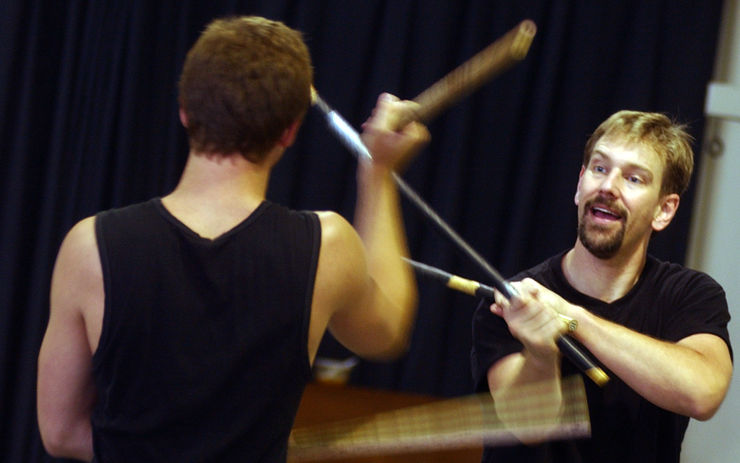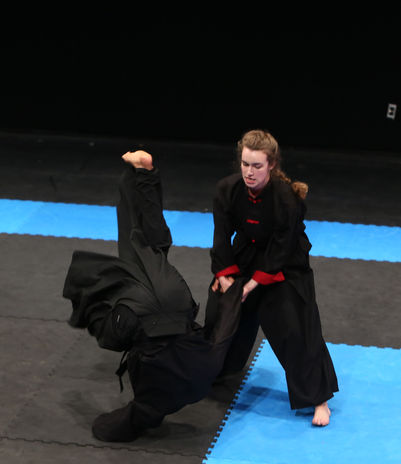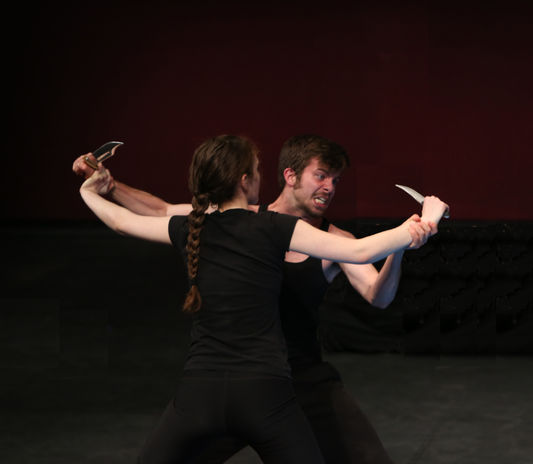
Martial Journey...

Dale Anthony Girard started his martial journey while studying theatre at the University of Northern Colorado, Greeley. In a general education self-defense class, he met Gregory Gonzales, who in turn introduced him to “real” martial arts and Filipino Arnis. While at UNC he studied knife, stick/double-stick and unarmed techniques in his instructor’s backyard. Training was old-school – always outdoors, no matter the weather. After two years, Dale moved to Denver and began training with Jonin Mark Steven Grove in Kurai Kotori Ryu Ninjutsu. There he studied taijutsu (unarmed combat), karujutsu (acrobatic skills), ukemi (break falls/falling) kihon nin-buki (the basic weapons of short staff, knife, chain and throwing blades), and kenjutsu (swordsmanship), eventually earning the rank of Yushi (1st Dan/Black Belt).
Moving from Denver to the east coast, Dale left the Ninjitsu dojo and bowed into the dojang. Serving on faculty for the Yale School of Drama, he joined the Yale Taekwondo club where he studied under Master Woosik Chung and Grand Master Ho Soo Hwang. There, he trained in traditional poomse (forms), kyuk pa (board breaking), sparring techniques, and also competed for several years. While training at Yale, Master Chung offered a series of classes in Gongkwon Yusul, a modern Korean martial art system derived, in part, from the martial arts of Hapkido, Hakko-ryu Jujutsu, and Judo. The wrestling, grappling and rolling/ground-work proved a strong compliment to the primarily standup techniques of Taekwondo.
Relocating again, this time to join the faculty of the North Carolina School of the Arts, Dale tried to continue his training in Gongkwon Yusul, but found no schools in the area offering the relatively new system. Instead, he found a school that offered classes in boxing, kickboxing and Brazilian Jujitsu. He trained there with a number of local law enforcement officers until the school closed two years later.
It was fortuitus that the school closed, as it opened the door for a return to the dojang, this time with his sons Matthew and Derek. Despite his previous ranks and training, Dale wanted to take the journey with his sons, so with his two “little tigers” he began training again as a white belt. Matthew, Derek and Dale studied Taekwondo, Hopkido and Haidong Gumdo under the tutelage of Grand Master Woo Sup Kim and other Korean Masters at Tiger Kim’s Taekwondo.
After the boys earned 2nd Poom (2nd degree black belt for those under 16) and Dale earned 3rd Dan (awarded through the Kukiwan, WT / USTU) they all bowed out of the dojang for a while. The boys moved on to other interests and Dale returned to the Filipino martial arts. Studying with Guru Brent Alton and his master, Guru Jimmy Tacosa, Dale spent the next two years working the stick, knife and unarmed techniques of Tacosa Escrima. Unfortunately, a serious, but unrelated, arm injury brought an abrupt end to his Escrima training.
Intent on continuing his martial journey, Dale began taking classes in Tai Chi where he was undergoing PT for his arm. There he met Sifu Casey Martin. Sifu Martin introduced Dale to the Chinese martial arts of Tai Chi, Wing Chun and Jun Fan Gung Fu. Under Sifu Martin, Dale progressed in these new disciplines and earned his Blue Sash in Jun Fan Gung Fu. Training would have continued, but for the pandemic of COVID-19. Sadly, Sifu Martin’s dojo did not reopen after the national shutdown.
In January of 2021, Dale returned once again to Taekwondo and Tiger Kim’s. He spent the next year reacquainting himself with the school’s techniques and curriculum and began training and testing toward for his 4th Dan/Master level. This, of course, will take several years. In the meantime, he continues to train and teach at Tiger Kim’s, where he is a senior instructor and proud member of the school’s staff.

TAE KWON DALE /
PERFORMANCE MARTIAL ARTS
Dale’s years of training in the martial and theatrical arts developed into a way of working that merged the tactical and practical applications of various armed and unarmed martial fighting styles with the needs of a safe, repeatable, character-driven, story-based narrative of stage combat. As his primary martial discipline is that of Taekwondo, his student at the North Carolina School of the Arts lovingly nicknamed his class “Tae Kwon Dale.” Clearly borrowed from the Korean martial art, the name and meaning has truth behind its good-humored conception. “Tae Kwon Do” literally translates into “the way of striking with the hands and feet.” As such, the name “Tae Kwon Dale” represents Dale’s specific way of fighting with the hands and feet (and weapons) for stage and screen combat. This martially based form of choreographed combat (whether presented by stunt performers or actors on stage or camera, or martial artists in a demonstrations) is also know as Performance Martial Arts.
Tae Kwon Dale is not a “martial art,” but rather a performance art based on first-hand knowledge of actual martial systems, tactics and techniques. Coming from a strong foundation of real, truthful martial practices, Dale’s teaching and choreographic style is in just fake fighting flavored with simple images and ideas of martial movement, it is martial movement safely adapted to creative storytelling. This allows for martially based action sequences that serve the story and help further the character’s narrative.





























